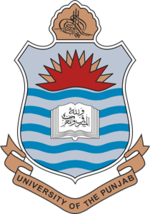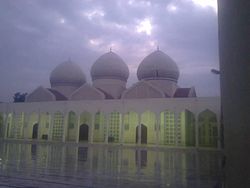 Coat of arms | |
Other name | Punjab University |
|---|---|
| Motto | ایمان، اتحاد، تنظیم (Aiman, Ittehad, Tanzeem) |
Motto in English | Faith, Education, Discipline |
| Type | Public research university |
| Established | 14 October 1882 [1] |
| Founders | Gottlieb Wilhelm Leitner |
Academic affiliations | |
| Chancellor | Governor of the Punjab |
| Vice-Chancellor | Dr. Muhammad Ali [2] [3] |
Academic staff | 1006 full time and 300 part time faculty members [4] |
| Students | 45,678 on campus students. (27,907 morning students, 16,552 evening students and 1,219 diploma students), 363,416 (off campus) [5] |
| Location | Canal Road, Quaid-e-Azam Campus, Lahore , , Pakistan |
| Campus | List
|
| Colours | Blue – Bronze – Red |
| Nickname | Pioneers |
| Website | pu |
 | |
 | |
The University of the Punjab (PU) is a public research university in Lahore, Punjab, Pakistan. Founded in 1882, its international influence has made it one of the most prestigious universities in South Asia; being the oldest and largest public sector one in the wider Punjab region, as well as in Pakistan. [4]
Contents
- History
- Pre Partition
- Founding Colleges
- Post Partition
- Campus
- Academics
- Rankings
- Faculties
- Constituent colleges
- Institutes
- Facilities
- Library
- Notable alumni
- Nobel Laureate
- Educationist
- Politicians
- Scientists
- Lawyers
- Judges
- Architects
- Literature
- Noted PU faculty
- Vice Chancellors
- See also
- References
- External links
The first meeting of the University's Senate was on 14 October 1882 at Simla, which marked the formal establishment of the university. [6] Punjab University was the fourth university to be established by the British colonial authorities in the Indian subcontinent; [6] the first three universities were established in other parts of British India. [7] [8]
There are 45,678 students (27,907 morning students, 16,552 evening students and 1,219 diploma students). The university has 19 faculties of which there are 138 academic departments, research centres, and institutes. [4] Punjab University has ranked first among large-sized multiple faculty universities by the HEC in 2012. [9] There are also two Nobel Laureates among the university's alumni and former staff. [4] Additionally, the university is also a member of the Association of Commonwealth Universities of the United Kingdom. [10] The university has campuses in Gujranwala, Jhelum, Khanaspur, and Pothohar Campus. [11]





